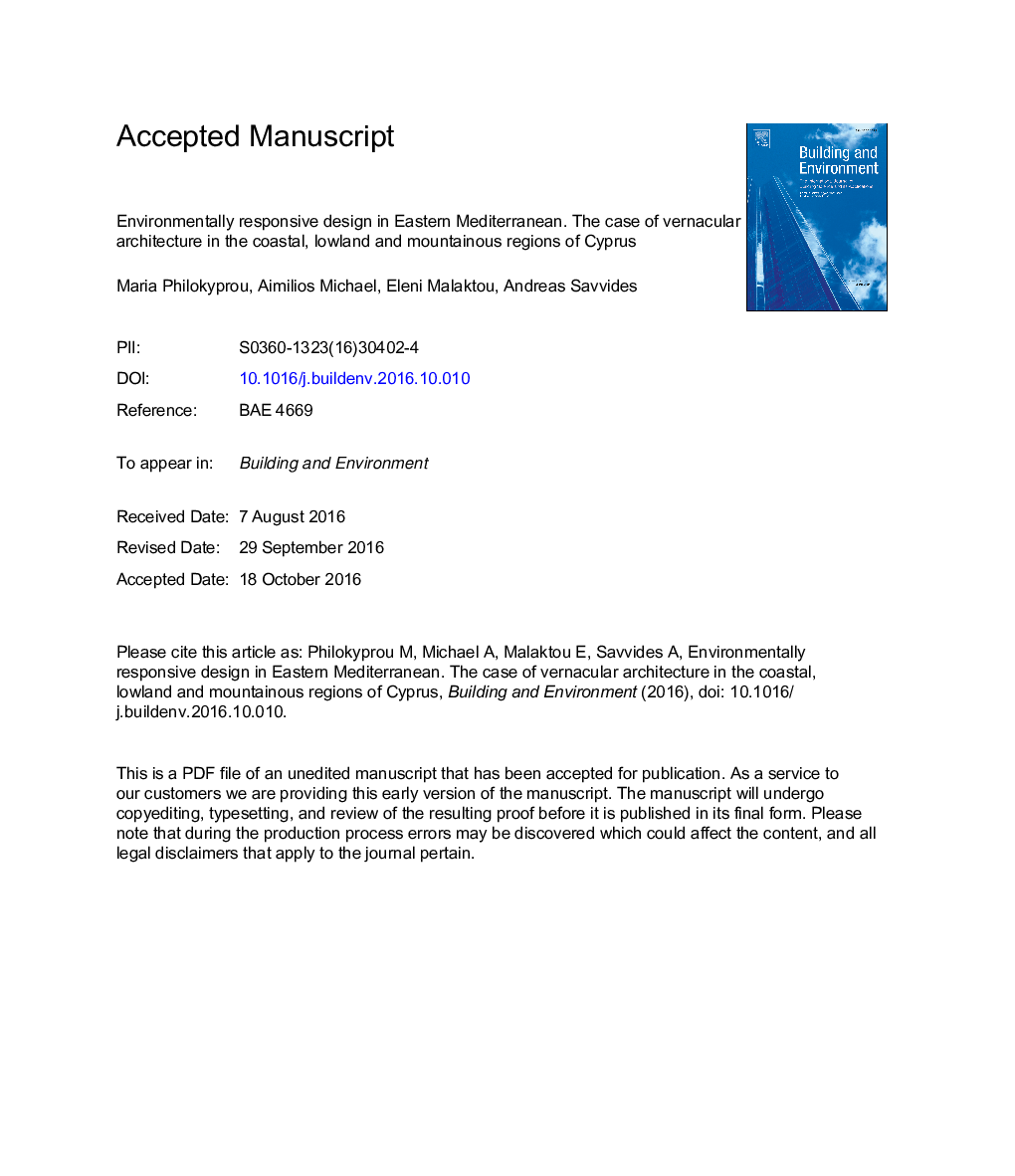| کد مقاله | کد نشریه | سال انتشار | مقاله انگلیسی | نسخه تمام متن |
|---|---|---|---|---|
| 4917509 | 1428381 | 2017 | 33 صفحه PDF | دانلود رایگان |
عنوان انگلیسی مقاله ISI
Environmentally responsive design in Eastern Mediterranean. The case of vernacular architecture in the coastal, lowland and mountainous regions of Cyprus
ترجمه فارسی عنوان
طراحی سازگار با محیط زیست در مدیترانه شرقی. مورد معماری بومی در مناطق ساحلی، کوهستانی و کوهستانی قبرس
دانلود مقاله + سفارش ترجمه
دانلود مقاله ISI انگلیسی
رایگان برای ایرانیان
کلمات کلیدی
طراحی پاسخگو با محیط زیست مناطق آب و هوایی، معماری بومی استراتژی های بیوکلیماتیک، مدیترانه شرقی،
ترجمه چکیده
صدها سال تجربه تجربی منجر به توسعه خانه های بومی و سازگار با محیط زیست و ژئومورفولوژی محلی شد تا نیازهای روزانه اشغالگران را برآورده سازد. در این راستا، معماری بومی به منظور طراحی معماری و مهندسی معاصر از نظر طراحی محیطی پاسخگو است. این مقاله بر روی یافته های تحقیق و پژوهش ادبی که در چارچوب یک برنامه تحقیقاتی بودجه دو ساله انجام شده است، به بررسی ابعاد طراحی زیست محیطی خانه های روستایی روستایی در مناطق ساحلی، کمین و کوهستانی قبرس می پردازد که ویژگی های متنوعی دارند ویژگی های توپوگرافی، زمین شناسی و اقلیمی. تحقیق بر تعداد معدودی از سکونتگاه های روستایی منجر به انتخاب نمونه های نمونه موردی و نیز انتخاب و تطبیق تعداد زیادی از خانه های بومی در شهرک های مورد نظر شد. توجه ویژه به ارتباط ساختار نوع ساختمان، پیکربندی فضاهای نیمه باز و فضای باز، مواد، روش های ساخت و ساز و ابعاد (اندازه و موقعیت) با جنبه های طراحی محیطی بود. مجموعه ای از ویژگی های طراحی بیولوژیکی کلاسیک، مربوط به کنترل میکرو کلاسیک در فضای باز، تکنیک های خنک کننده منفعل و حرارت، در هر منطقه اقیانوس اطلس ثبت شد. نتایج تحقیق توجه داشته باشید که معماری بومی، با چالش های خاص سازگاری که با شرایط محلی مطابقت دارد، با مشکل مواجه می شود. علاوه بر این، این نشان می دهد که معماری بومی، خود را به عنوان یک مدل برای یک رویکرد طراحی پایدار معرفی می کند. یافته های این مطالعه ممکن است در منطقه وسیع تر منطقه مدیترانه ای شرقی جایی باشد که ویژگی های نوعی، ساختاری و فضایی مشابه معماری بومی است.
موضوعات مرتبط
مهندسی و علوم پایه
مهندسی انرژی
انرژی های تجدید پذیر، توسعه پایدار و محیط زیست
چکیده انگلیسی
Hundreds of years of empirical expertise resulted in the development of vernacular dwellings adapted to the local climate and geomorphology in order to accommodate the daily needs of the occupants. In this respect, vernacular architecture has a lot to teach contemporary architects and engineers in terms of environmentally responsive design. This paper reports on the findings of a field research and literature study that was undertaken in the framework of a two-year funded research programme which investigates the environmental design dimensions of rural vernacular dwellings in the coastal, lowland and mountainous regions of Cyprus which feature diverse topographical, geological and climatic characteristics. The investigation of a significant number of rural settlements led to the selection of representative case studies, as well as to the selection and tabulation of a large number of vernacular dwellings, in the settlements in question. Special attention was paid to the interrelation of the building typology, semi-open and open spaces configuration, materials, construction techniques and openings (size and position) with aspects of environmental design. A series of diverse bioclimatic design features, related to outdoor microclimatic control, passive cooling and heating techniques, were recorded in each climatic region. The research results note that vernacular architecture addresses successfully specific adaptation challenges imposed by local conditions.Moreover, it indicates that vernacular architecture presents itself as a model for a sustainable design approach. The findings of this study may be of interest in the broader Eastern Mediterranean region where similar typological, constructional and spatial characteristics are incorporated in vernacular architecture.
ناشر
Database: Elsevier - ScienceDirect (ساینس دایرکت)
Journal: Building and Environment - Volume 111, January 2017, Pages 91-109
Journal: Building and Environment - Volume 111, January 2017, Pages 91-109
نویسندگان
Maria Philokyprou, Aimilios Michael, Eleni Malaktou, Andreas Savvides,
